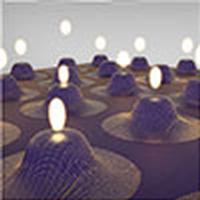Our official English website, www.x-mol.net, welcomes your
feedback! (Note: you will need to create a separate account there.)
Near-deterministic activation of room-temperature quantum emitters in hexagonal boron nitride
Optica ( IF 8.4 ) Pub Date : 2018-09-14 , DOI: 10.1364/optica.5.001128 Nicholas V. Proscia , Zav Shotan , Harishankar Jayakumar , Prithvi Reddy , Charles Cohen , Michael Dollar , Audrius Alkauskas , Marcus Doherty , Carlos A. Meriles , Vinod M. Menon
Optica ( IF 8.4 ) Pub Date : 2018-09-14 , DOI: 10.1364/optica.5.001128 Nicholas V. Proscia , Zav Shotan , Harishankar Jayakumar , Prithvi Reddy , Charles Cohen , Michael Dollar , Audrius Alkauskas , Marcus Doherty , Carlos A. Meriles , Vinod M. Menon

|
Applications of quantum science to computing, cryptography, and imaging are on their way to becoming key next-generation technologies. Owing to the high-speed transmission and exceptional noise properties of photons, quantum photonic architectures are likely to play a central role. A long-standing hurdle, however, has been the realization of robust, device-compatible single-photon sources that can be activated and controlled on demand. Here we demonstrate large arrays of room-temperature quantum emitters in two-dimensional hexagonal boron nitride (hBN). The large energy gap inherent to this van der Waals material stabilizes the emitters at room temperature within nanoscale regions defined by substrate-induced deformation of few-atomic-layer hBN. Combining analytical and numerical modeling, we show that emitter activation is the result of carrier trapping in deformation potential wells localized near the points where the hBN film reaches the highest curvature. Through the control of pillar geometry, we demonstrate an average of emitters per site for the smallest pillars (75 nm diameter). These findings set the stage for realizing arrays of room-temperature single-photon sources through the combined control of strain and external electrostatic potentials.
中文翻译:

六方氮化硼中室温量子发射体的近确定性激活
量子科学在计算,加密和成像方面的应用正在成为关键的下一代技术。由于光子的高速传输和出色的噪声特性,量子光子架构可能会发挥核心作用。然而,长期存在的障碍是实现可按需激活和控制的,与设备兼容的强大的单光子源。在这里,我们展示了二维六角形氮化硼(hBN)中的室温量子发射器的大型阵列。该范德华材料固有的大能隙使室温下的发射体稳定在纳米范围内,该范围是由衬底诱导的少数原子层hBN变形限定的。结合分析模型和数值模型,我们表明,发射极的激活是由于载流子捕获在hBN膜达到最高曲率的点附近的形变势阱中的结果。通过控制支柱的几何形状,我们证明了平均每个站点的发射器,用于最小的支柱(直径75 nm)。这些发现为通过应变和外部静电势的组合控制实现室温单光子源阵列奠定了基础。
更新日期:2018-09-21
中文翻译:

六方氮化硼中室温量子发射体的近确定性激活
量子科学在计算,加密和成像方面的应用正在成为关键的下一代技术。由于光子的高速传输和出色的噪声特性,量子光子架构可能会发挥核心作用。然而,长期存在的障碍是实现可按需激活和控制的,与设备兼容的强大的单光子源。在这里,我们展示了二维六角形氮化硼(hBN)中的室温量子发射器的大型阵列。该范德华材料固有的大能隙使室温下的发射体稳定在纳米范围内,该范围是由衬底诱导的少数原子层hBN变形限定的。结合分析模型和数值模型,我们表明,发射极的激活是由于载流子捕获在hBN膜达到最高曲率的点附近的形变势阱中的结果。通过控制支柱的几何形状,我们证明了平均每个站点的发射器,用于最小的支柱(直径75 nm)。这些发现为通过应变和外部静电势的组合控制实现室温单光子源阵列奠定了基础。











































 京公网安备 11010802027423号
京公网安备 11010802027423号